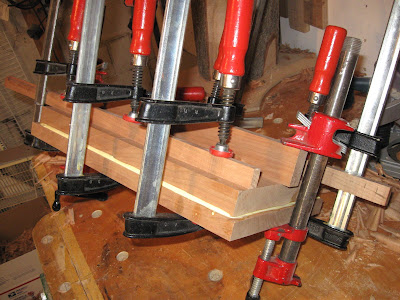



Sunday, November 30, 2008
Pedestal blanks
Thursday, November 27, 2008
More feet



Aside: I don't like the new camera!
Wednesday, November 26, 2008
Feet feat




Saturday, November 22, 2008
Some more progress on tables



Feet, pedestals, and finish remain.
Friday, November 21, 2008
Table progress


Thursday, November 20, 2008
Router table #2


Note the third hole on the right, thru which height adjustments can be made from ABOVE the table.
Sunday, November 16, 2008
Friday, November 14, 2008
1000 words

This was a plan to build the MDF cores for the table pedestals. One of my online WW'ing heroes shot this down as a waste of time and effort. Current plan is glue up a solid block and band-saw it out a-la cabriole leg.
Sunday, November 9, 2008
Design questions
Object now or forever hold your peace.
Ignore all the lines on the base - it was drawn by doing 1/4 of it and copying/flipping/rotating the pieces together. I don't know how to get rid of the lines joining them.
Edge profile on the top is a swag. Note the feet on the bottom of the base. This is to give it some height and prevent it wobbling. They can easily be changed, or pitched entirely.
Saturday, November 8, 2008
Chip out repair

Hand-planed it down and glued on a little repair block.

Sunday, November 2, 2008
Base chip-out repair

I hand planed the rough chipped-off edge flat, which allowed a few scraps to be glued on. After gluing, I trimmed the excess off to get it a little closer. I'll clean these up by sanding to the final shape so as to not chip out the repair.
Table Tops









